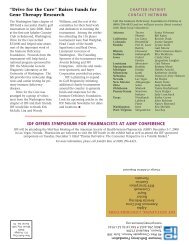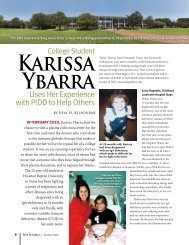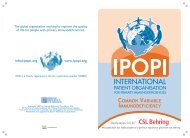IDF Patient & Family Handbook for Primary Immunodeficiency ... - IDFA
IDF Patient & Family Handbook for Primary Immunodeficiency ... - IDFA
IDF Patient & Family Handbook for Primary Immunodeficiency ... - IDFA
Create successful ePaper yourself
Turn your PDF publications into a flip-book with our unique Google optimized e-Paper software.
72<br />
Inheritance<br />
Inheritance of <strong>Primary</strong> <strong>Immunodeficiency</strong> Diseases<br />
Most of our physical and chemical characteristics<br />
are passed along from parents to children.<br />
Examples of these include the color of our eyes,<br />
our hair color, and the chemicals that determine<br />
our blood type. In the same manner, many of the<br />
primary immunodeficiency diseases are inherited,<br />
or passed on, in families. The chemical structures<br />
that are responsible <strong>for</strong> these characteristics, and<br />
the tens of thousands of other characteristics that<br />
make an individual unique are called genes. These<br />
genes are packaged on long, string-like structures<br />
called chromosomes. Every cell in the body<br />
contains all the chromosomes and consequently,<br />
all of the genes necessary <strong>for</strong> life.<br />
Each of our cells contains 23 pairs of chromosomes,<br />
hence, 23 sets of gene pairs. One of each pair of<br />
chromosomes is inherited from our mother while<br />
the other is inherited from our father. Since genes<br />
are on these chromosomes, we also inherit one<br />
gene (or message) <strong>for</strong> a certain characteristic (such<br />
as eye color) from our mother and one gene <strong>for</strong> the<br />
same characteristic from our father.<br />
During egg and sperm production, the total number<br />
of 46 parental chromosomes (23 pairs) is divided in<br />
half. One chromosome of each pair, and only one,<br />
is normally passed on in each egg or sperm. When<br />
fertilization of the egg occurs, the 23 chromosomes<br />
contained in the egg combine with the 23<br />
chromosomes in the sperm to restore the total<br />
number to 46. In this way each parent contributes<br />
half of his/her genetic in<strong>for</strong>mation to each offspring.<br />
All of the chromosomes except the sex<br />
chromosomes are called autosomes and are<br />
numbered from 1-22 according to size. One<br />
additional pair of chromosomes determines the<br />
sex of the individual. These are called the sex<br />
chromosomes and are of two types, X and Y<br />
chromosomes. As shown in Figure 1, females<br />
have two X chromosomes, and males have an X<br />
and a Y chromosome. As a result of having two<br />
X chromosomes, females can only produce eggs<br />
that have an X chromosome. In contrast, since<br />
men have both an X and Y chromosome, half of<br />
the sperm produced will contain an X chromosome<br />
and half will carry a Y chromosome. The sex of the<br />
baby is determined by which type of sperm fertilizes<br />
the egg. If the sperm that fertilizes (or combines<br />
with) the egg carries an X chromosome, the child<br />
that results will be a female. If the sperm carries a Y<br />
chromosome, the child that results will be a male.<br />
CHAPTER 15; FIGURE 1<br />
The Sex Chromosomes
















